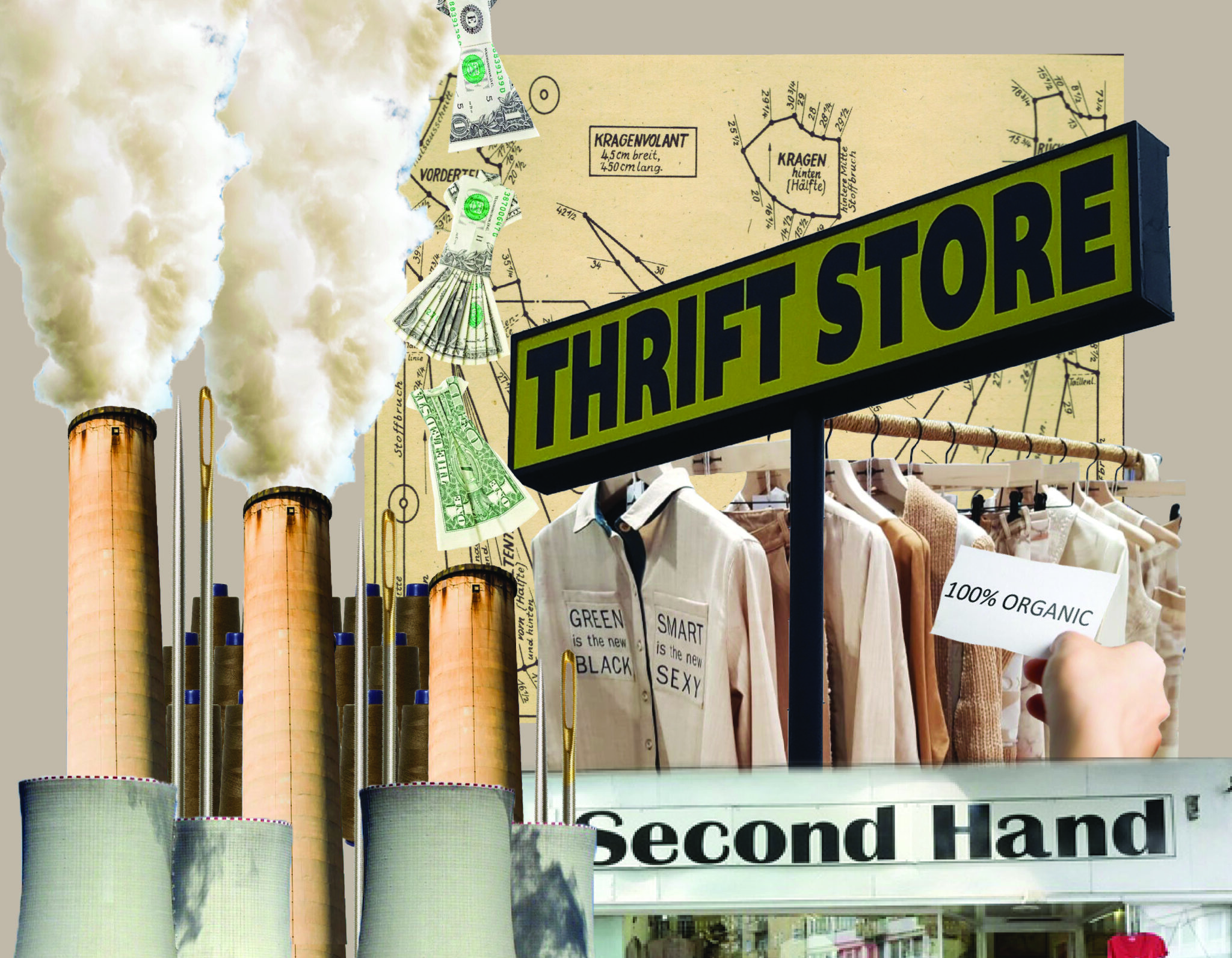GRAPHIC DESIGN Brennan March
Sustainable fashion has come a long way from its early and less aesthetically pleasing appearances in popular fashion media. Though its true origins are diverse in nature, much of today’s sustainable fashion has neglected to include the very people who championed the term. The majority of the advertising within sustainable fashion companies centres thin, white, upper-class models and rarely features QBIPOC and plus-size people. It’s nice to feel like we are contributing to a more ethical fashion world by purchasing eco-conscious pieces, but there are other ways to integrate sustainability into our wardrobe besides spending $50 on an organic cotton t-shirt.
As long as we’re buying things, we’re making decisions about who and what we want to support. In the digital age, the truth about fast fashion is easily accessible, but the active shift from ditching disposable fashion to adopting more ethical shopping habits is not as straightforward. In other words, people are realizing that purchasing clothing is not a neutral act with neutral consequences. The average pair of jeans from sustainable fashion company Reformation retail for about $138, and given the resurfacing of Reformation’s racist past, it’s not shocking that people are apprehensive to invest in this and other similar brands. Millennials and Gen Z have proven to be one of the biggest proponents of sustainability in fashion, yet there exists a certain level of privilege needed to participate in mainstream sustainable fashion.
Though sustainability is primarily marketed towards an affluent, white audience, sustainability isn’t an intrinsically exclusive and class-sensitive thing. Below you’ll find five different ways that people can participate in sustainable fashion without breaking the bank or unwittingly contributing to an unethical company.
Rethink your shopping habits
Before hunting for a new garment you need to evaluate whether or not you really need it. While yes, it’s fun to buy new things and keep up with the latest trends, it’s also important that we acknowledge the fashion industry’s lucrative relationship with impulsive consumption. If you’ve established that you absolutely must buy something new, I urge you to ask yourself how many times you see yourself wearing this garment. Many of us have experienced “needing” to buy a new outfit for an event, wearing it once, and then having it sit in our closets for the rest of eternity. Though outfit repeating is normalized with our casual clothes, we need to start thinking about outfit repeating for formal events; maybe your old prom dress can be worn again at a wedding, or it can be shortened into a cocktail dress. If you’ve weighed out all your options and getting a new fashion piece for your (small and social distanced) event is a must, you might want to consider renting it.
Be Your Own Designer
There are plenty of resources to help you begin the process of making your own clothes. If you have an old sewing machine lying around in your home, now is the time to take it out. New sewers can check out With Wendy’s YouTube channel. Her “Sewing for Beginners” video covers the sewing basics, while her other tutorials thoroughly walk through the process of sewing trendy fashion pieces. If you’re looking to sew a new dress for a special event, YouTuber and Designer Daniela Tabois has tutorials for you. In her videos, she’ll teach you how to drape and sew your own dresses. Perhaps, with the cold weather approaching, knitting is more your style; Mutherofpearl’s shop has a variety of inexpensive knitting patterns that can be bought online. YouTube has hundreds of tutorials to help you out when you get stuck, however, if making your own clothing from scratch sounds too intimidating, you can always upcycle old garments.
Rework your clothing to make it work for you
If you have access to a sewing machine or want to hand sew, try altering and reworking pieces that you no longer wear. If you’re looking for inspiration, April’s YouTube channel features her infamous thrift transformations as well as quick and easy tutorials on altering your own clothes. From recycled patchwork jackets to dresses made out of bed sheets, April sews just about everything. If you tend to gravitate towards vintage fashion, look to Adey’s youtube channel. Her channel incorporates thrifted vintage finds, turning them into popular, yet unique pieces, and her styling videos teach viewers how to style old clothing in new ways.
Organize a clothing swap with your friends
Are you looking to find a good home for that jacket at the back of your closet? Try organizing a (socially distant) clothing swap with your friends. A clothing swap is the perfect way to give new life to your old clothes, diversify your wardrobe, and get some cool pieces in return. The leftover clothing can be donated or upcycled.
Shop vintage, and support small businesses
If making and trading clothes isn’t for you, there are many amazing businesses that you can support. Investing in pieces that are thoughtfully made, ensures that your clothing won’t need to be replaced as often. Purchasing second hand and reworked fashion is better than buying new. Instead of encouraging unsustainable production processes you can purchase items that have already been made while also supporting small artists and businesses. When working with a tighter budget, your local thrift store is always a good option. Looking for pieces that are constructed well and made from quality materials can guarantee minimal wear and tear.
Sustainability isn’t just about buying the most “green” clothing: it’s about rethinking our consumption habits and being more aware of why we buy and who we buy from. Though the fashion industry still has a significant amount of work to do before it can become more sustainable, our purchasing power is not something to be underestimated. Change starts small and by beginning to think about consumption more consciously, we can demand a more sustainable fashion world.
























